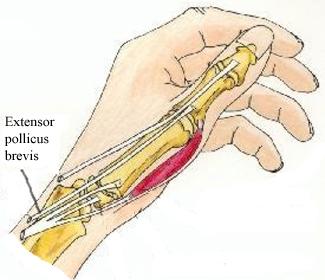- What is De Quervain’s tenosynovitis (washerwoman’s sprain)
- Statistics on De Quervain’s tenosynovitis (washerwoman’s sprain)
- Risk Factors for De Quervain’s tenosynovitis (washerwoman’s sprain)
- Progression of De Quervain’s tenosynovitis (washerwoman’s sprain)
- Symptoms of De Quervain’s tenosynovitis (washerwoman’s sprain)
- Clinical Examination of De Quervain’s tenosynovitis (washerwoman’s sprain)
- How is De Quervain’s tenosynovitis (washerwoman’s sprain) Diagnosed?
- Prognosis of De Quervain’s tenosynovitis (washerwoman’s sprain)
- How is De Quervain’s tenosynovitis (washerwoman’s sprain) Treated?
- De Quervain’s tenosynovitis (washerwoman’s sprain) References
What is De Quervain’s tenosynovitis (washerwoman’s sprain)
De Quervain’s tenosynovitis or washerwoman’s sprain, is a painful wrist condition involving two of the tendons at the wrist – the thumb extensors called Extensor pollicus brevis and abductor pollicus longus at the base of the thumb.

Statistics on De Quervain’s tenosynovitis (washerwoman’s sprain)
This condition is usually seen in patients age 40-50 typically, though patients of other ages may be affected.
Risk Factors for De Quervain’s tenosynovitis (washerwoman’s sprain)
Despite the name (washerwoman’s sprain) – the condition is seen in men as well as women, and can occur with any profession/activity involving rapid, repetitive movements of the thumb and wrist – eg wringing clothes, assembly line workers.
Progression of De Quervain’s tenosynovitis (washerwoman’s sprain)
- There may be a gradual onset of a dull ache, or an acute flare-up.
- The pain is worse with activities such as turning on taps, turning door handles, lifting teapots – anything requiring grasping.
- The pain often subsides with time if the person abstains from the activity.
How is De Quervain’s tenosynovitis (washerwoman’s sprain) Diagnosed?
No investigations are necessary.
Prognosis of De Quervain’s tenosynovitis (washerwoman’s sprain)
This is not a serious condition, though it can be reasonably disabling in the sense that it limits the use of the hand – writing, performing occupational activities. It usually lasts for months – though this depends on treatment and whether the exacerbating activity is stopped.
How is De Quervain’s tenosynovitis (washerwoman’s sprain) Treated?
- Rest, with avoidance of the causative stress on the thumb abductor and extensors.
- A splint can be used – one that immobilises the wrist, and also involves the thumb.
- Corticosteroid injections into the tendon sheath can help.
- Surgical release may be required in chronic cases.
De Quervain’s tenosynovitis (washerwoman’s sprain) References
- Kumar P, Clark M. CLINICAL MEDICINE. WB Saunders 2002.
- Moore, KL, Clinically orientated anatomy 3rd ed; Williams and Wilkins, 1992.
- Murtagh, J. General Practice. Second Ed. McGraw-Hill, 1998.
All content and media on the HealthEngine Blog is created and published online for informational purposes only. It is not intended to be a substitute for professional medical advice and should not be relied on as health or personal advice. Always seek the guidance of your doctor or other qualified health professional with any questions you may have regarding your health or a medical condition. Never disregard the advice of a medical professional, or delay in seeking it because of something you have read on this Website. If you think you may have a medical emergency, call your doctor, go to the nearest hospital emergency department, or call the emergency services immediately.







